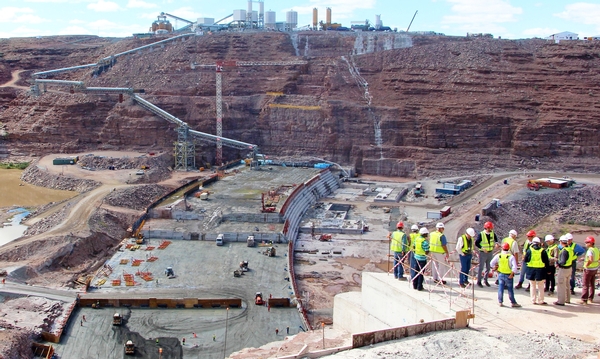

ICOLD 2016 Study Tour Visits Neckartal Dam Site
May 26, 2016, Windhoek, Namibia – On Friday, May 13, a group of roller-compacted concrete (RCC) dam specialists and dam engineers from various countries visited the Neckartal Dam site as part of a pre-conference technical tour arranged for the 84th ICOLD Annual Meeting and Symposium, which was held in Johannesburg, South Africa, on May 15-20, 2016.
Located along the Fish River close to Keetmanshoop in the Karas region, the Neckartal Dam—the highest and largest dam in Namibia—is an RCC single curvature mass gravity dam, with a height of 80 m, a crest length of 520 m, and a gross storage capacity of 850 Mm3 of water that will be used to irrigate 5,000 ha of land for agricultural development. Knight Piésold has been working on the project since 2010 and is responsible for the detailed design of the dam and associated water conveyance scheme.
The much-anticipated tour kicked off with presentations by Knight Piésold’s Gawie Steyn, the design project manager, and Salini’s Fabrizio Lazzarin, the contractor’s site engineer. Gawie discussed the purpose of the dam, dam basin topography, design approach, model studies for the spillway design, and construction challenges expected in the preparation of the foundation. He also discussed design challenges faced in transferring the dam’s water to the proposed irrigation areas.
Fabrizio discussed the construction programme as well as challenges faced relating to the temporary works and flood risk. Regarding the dam construction, the current rate of placing RCC is 3,000 m3 per day in two shifts. The contractor expects the placing rate to increase to 4,000 m3 per day once the conveyor system is put into operation. A visiting RCC specialist from Spain proposed that, with the available plant, the rate of placing could increase by 10 to 20%.
After visiting the Neckartal Dam, the tour stopped at the Naute Dam—the third largest dam in Namibia—located just outside of Keetmanshoop. The day ended with a stop at the nearby Fish River Canyon viewpoint—the world’s second largest canyon. On Saturday, en route back to Windhoek, the tour visited two large dams of the Namibia Water Corporation (NamWater), namely the Hardap and Oanob Dams. NamWater staff attending the tour presented operation and maintenance challenges faced at these dams. On Sunday morning, en route to the airport, a visit to the N/a’an kusê Wildlife Conservation Foundation gave delegates a view of some lion, leopard, and cheetah before flying back to Johannesburg.